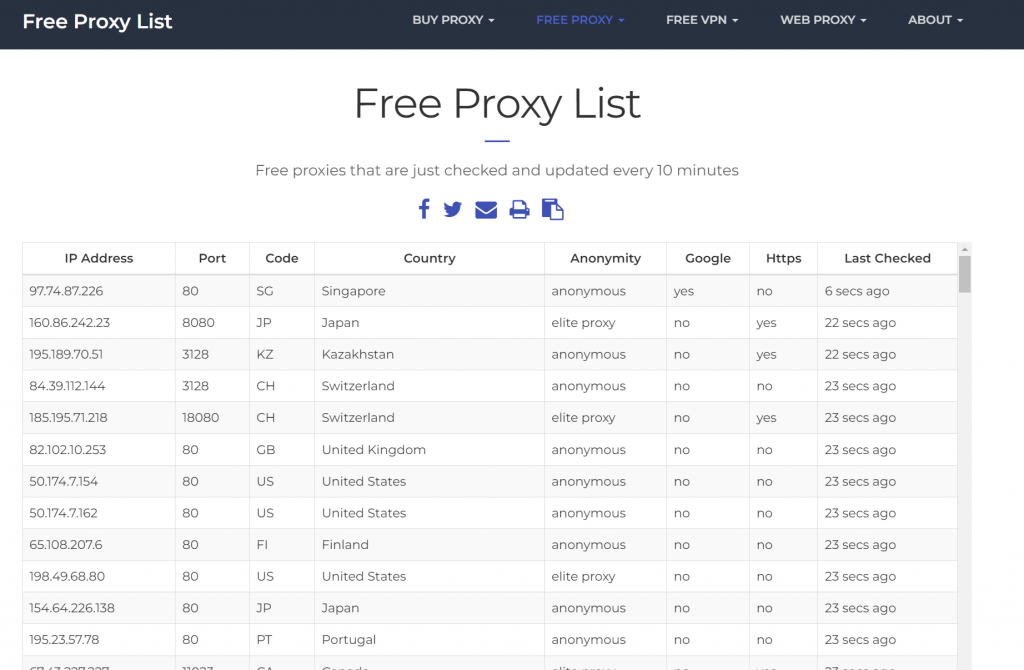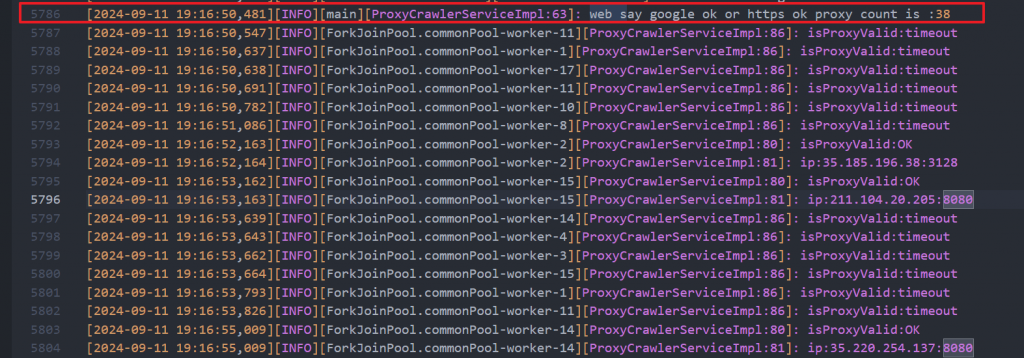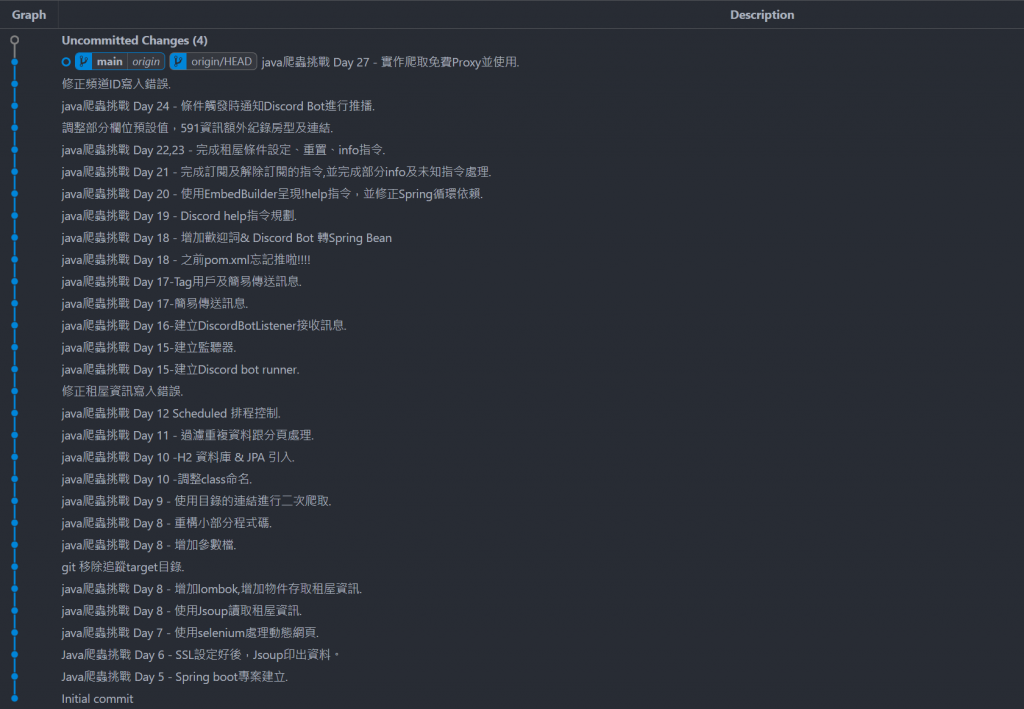昨天已經介紹過為什麼要使用Proxy了,今天就直接實作。
要將下圖中的ip、port存下來使用
右鍵=>檢視原始碼 就可以看到相關資訊了,所以是靜態網頁,直接用Jsop就好了。
取得Dom物件後,將Table裡的資料取出即可。
@Entity
@Data
public class Proxy {
@Id
@GeneratedValue(strategy = GenerationType.AUTO)
private Long id;
private String ip;
private int port;
public Proxy(String ip, int port) {
this.ip = ip;
this.port = port;
this.active = true;
}
}
public interface ProxyRepository extends JpaRepository<Proxy, Long> {
}
public interface ProxyCrawlerService {
List<Proxy> getProxies() throws IOException;
}
主要的邏輯都在這邊了,簡單說明一下要做甚麼。
@Override
public List<Proxy> getProxies() throws IOException {
String url = "https://www.free-proxy-list.net/";
List<Proxy> proxies = new ArrayList<>();
Document doc = Jsoup.connect(url).get();
// 找到代理表格的 tbody 部分
Element tableBody = doc.select("table.table tbody").first();
if (tableBody != null) {
// 取得表格中的每一行
Elements rows = tableBody.select("tr");
// 遍歷每一行,並擷取數據
for (Element row : rows) {
Elements cells = row.select("td");
// 如果列數符合表格的預期
if (cells.size() >= 8) {
String ipAddress = cells.get(0).text();
String port = cells.get(1).text();
String country = cells.get(3).text();
String anonymity = cells.get(4).text();
String google = cells.get(5).text();
String https = cells.get(6).text();
String lastChecked = cells.get(7).text();
if ("yes".equals(google) || "yes".equals(https))
proxies.add(new Proxy(ipAddress, Integer.parseInt(port)));
}
}
} else {
System.out.println("表格找不到!");
}
log.info("web say google ok or https ok proxy count is :{}", proxies.size());
List<Proxy> collect = proxies.parallelStream().filter(pro -> isProxyValid(pro.getIp(), pro.getPort()))
.collect(Collectors.toList());
log.info("ok proxy count is :{}", collect.size());
return collect;
}
public boolean isProxyValid(String ip, int port) {
try {
java.net.Proxy proxy = new java.net.Proxy(java.net.Proxy.Type.HTTP, new InetSocketAddress(ip, port));
URL url = new URL("https://rent.591.com.tw/list");
HttpURLConnection connection = (HttpURLConnection) url.openConnection(proxy);
connection.setConnectTimeout(5000); // 5 seconds timeout
connection.connect();
boolean b = connection.getResponseCode() == 200;
log.info("isProxyValid:{}", b ? "OK" : "Fail");
log.info("ip:{}:{}", ip, String.valueOf(port));
return b;
} catch (IOException e) {
log.info("isProxyValid:{}", "timeout");
return false;
}
}
新預計8小時更新一次Proxy
proxy.update.schedule=0 0 0/8 * * ?
總之就是時間到了,就去爬取免費Proxy,然後存到DB中。
@Service
public class UpdateProxyScheduler {
@Autowired
ProxyCrawlerService proxyCrawlerService;
@Autowired
ProxyRepository proxyRepository;
@PostConstruct
public void runOnceAtStartup() {
updateProxySchedule();
}
@Scheduled(cron = "${proxy.update.schedule}")
public void scheduledCrawl() throws Exception {
updateProxySchedule();
}
private void updateProxySchedule() {
List<Proxy> proxies = Collections.emptyList();
try {
proxies = proxyCrawlerService.getProxies();
} catch (IOException e) {
e.printStackTrace();
}
proxyRepository.saveAll(proxies);
}
}
先使用ProxyRepository
@Autowired
private ProxyRepository proxyRepository;
調整方法=>getJsoupDoc,之前是Jsop直接訪問591,現在使用Jsop的proxy方法,指定使用資料庫中的隨機proxy。
並且失敗的話,回從新再執行一次該方法。 (應該要設個失敗上限次數,偷懶沒寫)
private Document getJsoupDoc(String urlString) {
List<Proxy> proxies = proxyRepository.findAll();
Proxy randomProxy = proxies.get(new Random().nextInt(proxies.size()));
log.info("use proxy ip:{}:{}", randomProxy.getIp(), String.valueOf(randomProxy.getPort()));
Connection connection = Jsoup.connect(urlString)
.proxy(randomProxy.getIp(), randomProxy.getPort())
.timeout(10000);
// Add headers or user-agent if needed
Document doc = null;
try {
doc = connection.get();
log.info("use proxy ip:{}:{} => OK", randomProxy.getIp(), String.valueOf(randomProxy.getPort()));
return doc;
} catch (IOException e) {
log.error("proxy連線異常,message:{}", e);
return getJsoupDoc(urlString);
}
}
FreeProxyList提供了300個免費Proxy,我只使用可以連上google或https的,共38個。
結果只有3個,傻眼。 (最慘的時候只有一個能用
成功使用proxy取得591資料
https://github.com/a951753sxd/rental-crawler
今天成功爬取免費Proxy並存入資料庫中供591爬蟲模組使用,今天的實作也是意義重大,可以說是把第5~12天的進度透過不同的目標又進行了一次實作。
程式開發開發真的告一個段落了,接下來的三天就打打字,聊聊一些我的心得吧XD。
